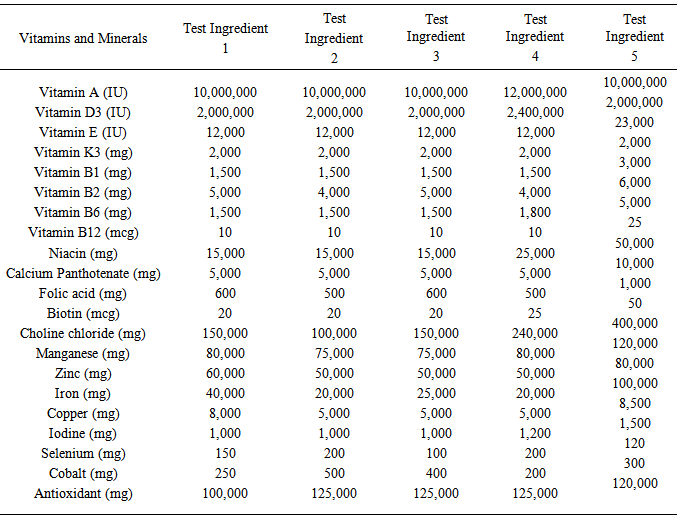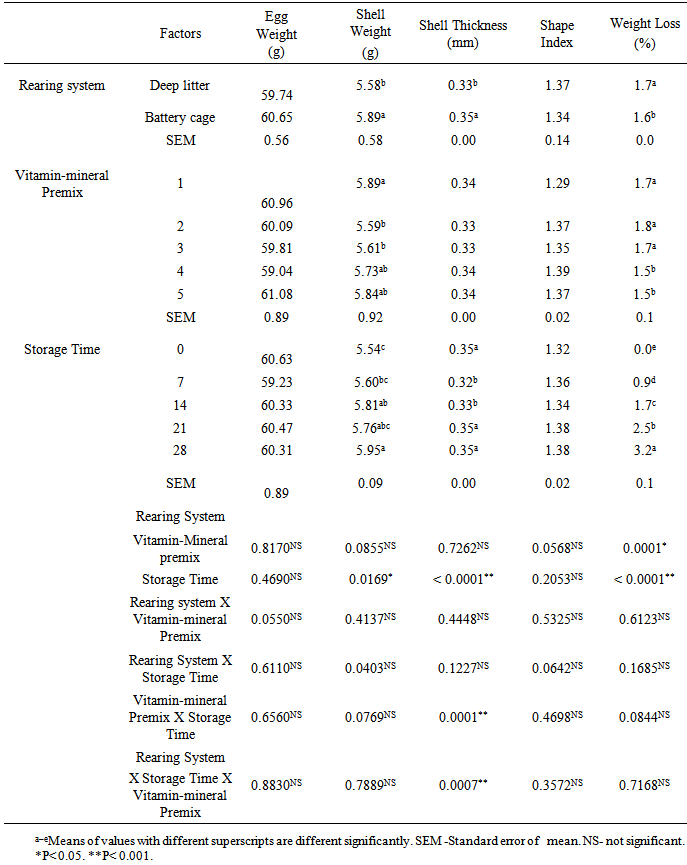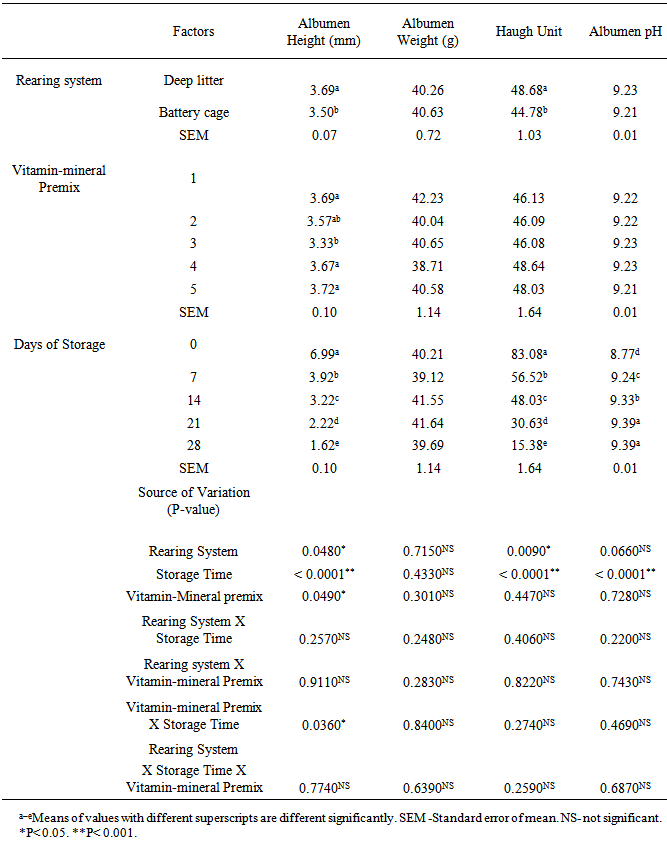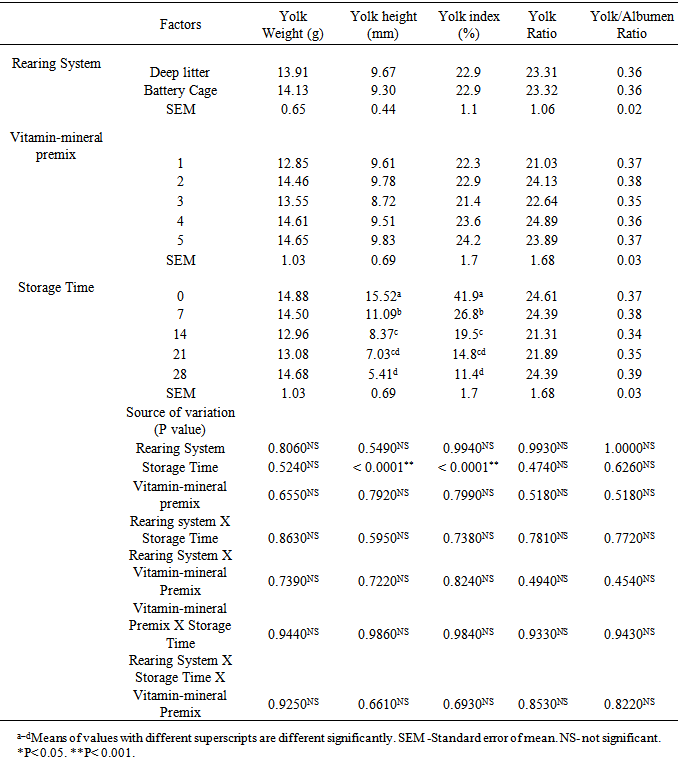-
Paper Information
- Next Paper
- Paper Submission
-
Journal Information
- About This Journal
- Editorial Board
- Current Issue
- Archive
- Author Guidelines
- Contact Us
International Journal of Food Science and Nutrition Engineering
p-ISSN: 2166-5168 e-ISSN: 2166-5192
2015; 5(1): 59-67
doi:10.5923/j.food.20150501.08
Proximate Composition and Physical Characteristics of Eggs from Laying Chickens Fed Different Proprietary Vitamin-Mineral Premixes Under Two Rearing Systems During Storage
Olugbenga Adeniran Ogunwole, Akinola Yinka Paul Ojelade, Mutiu Oyeyemi Oyewo, Emem Aquawo Essien
Agricultural Biochemistry & Nutrition Unit, Department of Animal Science, University of Ibadan, Ibadan, Nigeria
Correspondence to: Olugbenga Adeniran Ogunwole, Agricultural Biochemistry & Nutrition Unit, Department of Animal Science, University of Ibadan, Ibadan, Nigeria.
| Email: |  |
Copyright © 2015 Scientific & Academic Publishing. All Rights Reserved.
The proximate composition and physical characteristics of eggs from laying chickens fed diets supplemented with five different proprietary vitamin-mineral premixes (VMP) under two rearing systems (RS) in the duration of storage (DOS) were assessed. A 240 twenty week-old black Bovan nera chickens at the point of lay were randomly allotted equally to two RS in the deep litter (DL) and battery cages (BC)., Pullets were further allocated in each RS to five dietary treatments of 24 birds per treatment each in triplicate of eight birds per replicate. Five isocaloric and isonitrogenous diets formulated were each supplemented with 0.25% of the different VMP 1, 2, 3, 4 and 5 to obtain treatments T1, T2, T3, T4 and T5 respectively. Experimental diets and water were offered to respective birds ad libitum. At week 36, 75 eggs were sampled from each RS, stored at room temperature and thereafter assayed at days 0, 7, 14, 21 and 28. The experiment was a 2 X 6 X 5 factorial arrangement in completely randomized design. Crude protein (11.63%) and ether extract (7.67%) were significantly higher (P<0.05) in eggs from hens fed T1 compared to others. Crude protein (11.45 to 11.59), and ash (1.24 to 1.34) increased significantly (P<0.05) with decreased moisture content during storage. Shell thickness, weight loss, albumen height, and Haugh unit were significantly affected (P<0.05) by the DL. Egg albumen heights from birds fed diets T1 (3.69), T4 (3.67) and T5 (3.72) were significantly higher (P<0.05) compared to that fed T3. Haugh unit (83.08 to 15.38), albumen height (6.99 to 1.62), yolk height (15.52 to 5.41) and yolk index (41.94 to 11.38) decreased while albumen pH (8.77 to 9.39) and weight loss (0.0 to 3.2) increased significantly (P<0.05) with DOS. Interaction among RS, VMP type and DOS were not significantly different (P>0.05) for all parameters measured. Haugh unit and yolk index relative to DOS both gave negative and highly significant (P<0.01) regression equations: y = 0.000x4-0.044x3+0.864x2-7.915x+83.08 (R2 =0.874) and y = -0.000x3 +0.050x2-1.861x+41.89 (R2 =0.935) respectively. Conclusively, extent of reduction in egg quality in the DOS was influenced by the different dietary VMP employed in the feeding as well as the hens RS.
Keywords: Duration of storage, Haugh unit, Chemical composition, Egg quality indices, Yolk index
Cite this paper: Olugbenga Adeniran Ogunwole, Akinola Yinka Paul Ojelade, Mutiu Oyeyemi Oyewo, Emem Aquawo Essien, Proximate Composition and Physical Characteristics of Eggs from Laying Chickens Fed Different Proprietary Vitamin-Mineral Premixes Under Two Rearing Systems During Storage, International Journal of Food Science and Nutrition Engineering, Vol. 5 No. 1, 2015, pp. 59-67. doi: 10.5923/j.food.20150501.08.
Article Outline
1. Introduction
- Vitamin and mineral supplementations in layer diet remained indispensable due to their participation in all biochemical processes and chicken gut flora provide very little vitamin synthesis but compete with the host for dietary vitamins [1]. Chicken eggs contain high-quality proteins, carbohydrates, easily digestible fats and minerals, as well as valuable vitamins [2]. The use of quality premix is an important feature of a successful poultry production leading to improved safety, reliability and performance [3] of laying birds and quality of eggs produced. However, in Nigeria like some other developing countries, refrigeration of eggs is seldom practiced and eggs produced are temporarily stored at room temperature until sold to final consumers. Apart from direct human consumption, eggs are valuable raw materials for the pharmaceutical and cosmetic industries due to their multifunctional properties like foaming, gelling and emulsifying [4] which are highly dependent on interior and exterior characteristics reflected both in the quality and size [5]. The quality is composed of those characteristics of egg that affects its acceptability to consumers such as cleanliness, freshness, weight, shell quality; yolk index, albumen index, Haugh unit and chemical composition [6]. As reported [7-9], egg quality is influenced by management, climatic factors, nutrition, breed and post-lay handling practice. Eggs are highly susceptible to internal quality deterioration during storage [10] depending on shell and internal content [11, 12]. Factors associated with the level of quality loss are time, temperature, humidity, air movement and handling [13]. There is therefore the need for further documentation of the effects of dietary VMP vis a vis possible interaction of RS on DOS of eggs in the hot humid tropical environment. Therefore, this study was aimed at evaluating the proximate composition and physical characteristics of eggs from hens fed different commercial VMP under two RS as affected by the DOS.
2. Materials and Methods
- The study was carried out at the Poultry Unit, Teaching and Research Farm, University of Ibadan, Ibadan, Nigeria. 240 twenty weeks old black Bovan nera at the point of lay were allotted to two RS (i.e. BC and DL systems) with 120 birds per RS. In each RS, birds were randomly allotted to six dietary treatments in triplicate of eight birds per replicate making 24 birds per treatment. Five isonitrogenous and isocaloric layer diets were formulated. The composition of the experimental diets is shown in the Table 1. The feed were each supplemented respectively with 0.25% Nutripoult (T1), Hinutrients (T2), Agrimix (T3), Daramvita (T4) and Micromix (T5). The experimental diets and water were given to the birds ad libitum for fifteen weeks. Table 2 shows the composition of the test VMP as shown on the respective labels.
|
|
- At week 36, a total of 75 eggs were sampled from each RS, they were stored at room temperature for 28 days and were subsequently withdrawn serially for analyses on days 0, 7, 14, 21 and 28. Recorded minimum and maximum ambient temperature in the DOS of eggs were 23.4 and 27.9℃ respectively while the relative humidity ranged between 73 to 87%. Proximate compositions and physical characteristics (external and internal) of the eggs were measured at days 0, 7, 14, 21 and 28 DOS. Each egg was homogenized and the proximate composition determined [14]. Egg length and diameter were measured with electronic venier caliper. Eggs were weighed and broken on a flat surface, and the height of thick albumen was measured with a tripod micrometer. The albumen and yolk were separated, and only yolk was weighed. Shell thickness was measured with micrometer screw gauge after air drying at room temperature. Egg weight loss was determined as the difference between successive weights of eggs at different weighing days. Albumen weight was determined by the difference between egg weight, yolk weight and shell weight while albumen pH was measured with pH meter. Yolk index was estimated from the ratio of yolk height to yolk width. Haugh unit was determined from albumen height and egg weight using the equation as described [15]; HU= 100log (h + 7.6 - 1.7W0.37) where HU is Haugh unit, h is albumen height (mm), W= egg weight (g).
2.1. Statistical Analysis
- Data were analyzed using three way analysis of variance [16] while significant means were separated by least squares method.
3. Results and Discussion
- Effect of RS and VMP in the DOS on proximate composition of chicken eggs is shown in Table 3. The crude protein (CP) varied only numerically (P>0.05) among treatments and was not affected by RS. This observation conformed to the documented opinion [17] that egg displayed very consistent composition with regard to its content of total proteins, essential amino acids, total lipids, phospholipids, phosphorus, and iron. Also, protein and total lipid content of eggs were noted [18] not to be affected by the diet of the hen but the types of lipids (fatty acid composition) which in a way contradicted other proximate values of ether extracts (EE), total ash and nitrogen free extracts in Table 3. It was observed that dietary VMP type altered the moisture, CP and EE composition of eggs in this study highly significantly (P<0.01). The CP and EE (11.63 and 7.67 respectively) were significantly higher (P<0.01) in eggs from hen fed diets containing T1 compared to others. In the DOS, CP (11.45 to 11.59), and ash (1.24 to 1.34) increased very significantly (P<0.01) with decreased moisture content. Aside from EE composition, the DOS altered other proximate values highly significantly (P<0.01). The interactions of DOS X VMP only resulted in significantly different (P<0.05) EE values. Also, the interactions of the RS X VMP altered all eggs proximate values highly significantly (P<0.01). However, the interactions of RS X DOS and the RS X VMP type X DOS on egg proximate parameters were all not significantly different (P>0.05).
|
|
|
 | (1) |
 | Figure 1. Effects of Duration of Storage on Haugh Unit of chickens Egg |
|
 | (2) |
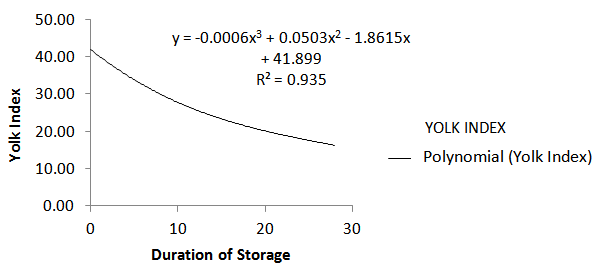 | Figure 2. Effect of Duration of Storage on Yolk Index of Chickens Egg |
4. Conclusions and Recommendations
- The RS and the type of dietary VMP both affected the composition and egg quality characteristics in the DOS. The VMP 1 and 5 would be preferred in both RS as they both tend to ensure good albumen height, Haugh unit, yolk height, yolk index, higher shell thickness and lowered weight loss. Quality of eggs was observed to decrease when stored at room temperature. Eggs qualities deteriorated bellow desirable grade before day 7 of storage at room temperature in the hot humid tropics. Thus, alternative methods should be considered for storing excess eggs produced to enhance retention of freshness.
 Abstract
Abstract Reference
Reference Full-Text PDF
Full-Text PDF Full-text HTML
Full-text HTML
